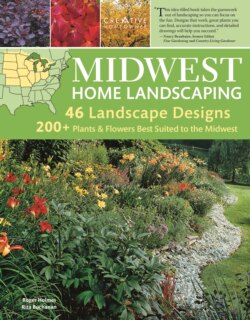Читать книгу Midwest Home Landscaping, 3rd edition - Rita Buchanan - Страница 7
На сайте Литреса книга снята с продажи.
ОглавлениеAbout the Authors
Roger Holmes is the founding editor of Fine Gardening magazine. He co-edited the monumental Taylor’s Master Guide to Gardening and other highly regarded gardening books, and produced the landscaping series of which this book is part. He also co-wrote Creative Homeowner’s Creating Good Gardens.
Rita Buchanan is a lifelong gardener with degrees in botany and an encyclopedic knowledge of plants. She worked with Roger Holmes to edit Fine Gardening magazine and co-edit several books, including Taylor’s Master Guide to Gardening. She is the author of numerous award-winning books and is a contributor to many gardening magazines.
Safety First
Though all concepts and methods in this book have been reviewed for safety, it is not possible to overstate the importance of using the safest working methods possible. What follows are reminders—do’s and don’ts for yard work and landscaping. They are not substitutes for your own common sense.
■ Always use caution, care, and good judgment when following the procedures described in this book.
■ Always determine locations of underground utility lines before you dig, and then avoid them by a safe distance. Buried lines may be for gas, electricity, communications, or water. Start research by contacting your local building officials. Also contact local utility companies; they will often send a representative free of charge to help you map their lines. In addition, there are private utility locator firms that may be listed in your Yellow Pages. Note: previous owners may have installed underground drainage, sprinkler, and lighting lines without mapping them.
■ Always read and heed the manufacturer’s instructions for using a tool, especially the warnings.
■ Always ensure that the electrical setup is safe; be sure that no circuit is overloaded and that all power tools and electrical outlets are properly grounded and protected by a ground-fault circuit interrupter (GFCI). Do not use power tools in wet locations.
■ Always wear eye protection when using chemicals, sawing wood, pruning trees and shrubs, using power tools, and striking metal onto metal or concrete.
■ Always read labels on chemicals, solvents, and other products; provide ventilation; heed warnings.
■ Always wear heavy rubber gloves rated for chemicals, not mere household rubber gloves, when handling toxins.
■ Always wear appropriate gloves in situations in which your hands could be injured by rough surfaces, sharp edges, thorns, or poisonous plants.
■ Always wear a disposable face mask or a special filtering respirator when creating sawdust or working with toxic gardening substances.
■ Always keep your hands and other body parts away from the business ends of blades, cutters, and bits.
■ Always obtain approval from local building officials before undertaking construction of permanent structures.
■ Never work with power tools when you are tired or under the influence of alcohol or drugs.
■ Never carry sharp or pointed tools, such as knives or saws, in your pockets. If you carry such tools, use special-purpose tool scabbards.
The Landscape Designers
Carter Lee Clapsadle is landscape horticulturist with the College of St. Catherine, St. Paul, Minn. Trained at the University of Minnesota in horticulture and plant biology, Mr. Clapsadle has many years’ experience as a nurseryman and garden designer in Oregon, Alaska, and Minnesota. He currently maintains 110 acres of college land, managing the greenhouse and designing and implementing garden displays. Mr. Clapsadle teaches design classes at the University of Minnesota through the Practical Scholar Program. He has received awards for urban beautification, garden tours, and landscaping from the city of Anchorage and the state of Alaska. His designs appear on page, 32–35, 36–39, 40–43, 72–75, and 108–111.
Larry Giblock came to horticulture in the early 1980s from a career in fashion design. He assisted with field studies of native plants at the Cleveland Natural History Museum and was instrumental in forming the Native Plant Society of Ohio. In 1988 the Cleveland Botanical Garden hired him to develop and oversee their Wildflower Garden, and in 1993 care of the Japanese Garden was added to his responsibilities. Mr. Giblock’s residential garden designs draw on gardening traditions of Eastern as well as Western cultures and emphasize native plants, local materials, and the work of local craftspeople. His designs appear on page, 60–63, 96–99, 100–103, and 104–107.
Jan Little is manager of horticultural education at the Morton Arboretum in Lisle, Ill. A registered landscape architect, she has worked on a wide range of projects, including residential and commercial lanscapes, woodland restoration, public gardens, and urban renovations. Ms. Little’s public beautification projects for Geneva, Ill. (where she lives and works), have received several landscape design awards. Her designs appear on page, 56–59, 76–79, 80–83, 84–87, and 88–91.
Michael Schroeder, a University of Minnesota graduate, has practiced landscape architecture and urban design in the region since 1985. He works for Hoisington Koegler Group, Inc., in Minneapolis, where he has done award-winning work helping communities develop their own design strategies. Mr. Schroeder teaches a class in landscape design for homeowners at the Minnesota Landscape Arboretum. Residential landscape design is his avocation, and he enjoys trying out ideas on his own property in Edina, Minn. His designs appear on page, 44–47, 52–55, 64–67, 68–71, and 92–95.
